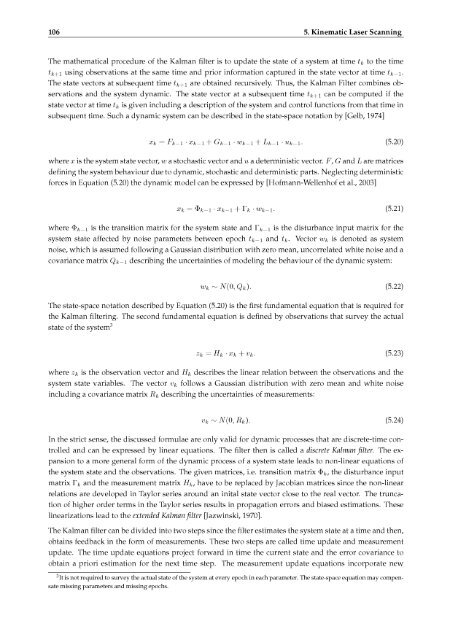Calibration of a Terrestrial Laser Scanner - Institute of Geodesy and ...
Calibration of a Terrestrial Laser Scanner - Institute of Geodesy and ...
Calibration of a Terrestrial Laser Scanner - Institute of Geodesy and ...
Create successful ePaper yourself
Turn your PDF publications into a flip-book with our unique Google optimized e-Paper software.
propagationresults series Taylorterms order parameter.highereachestimatesepoch trunca¬ filtermeasurements.everyform system vector. sincecovariance<strong>of</strong>realfeedbackactual close [Jazwinski,into obtainsparametersbe divided then,surveycancalledcurrent step. sateinital estimations.atime arerequired compen¬ around biased extended Kaimanstepsnextnot maylinearizationstw<strong>of</strong>orward aprioriequations3It state-spacemissingerrorslead 1970].These update. projectincorporatenew<strong>and</strong>106 5. Kinematic <strong>Laser</strong> ScanningThe mathematical procedure <strong>of</strong> the Kaiman filter is to update the state <strong>of</strong> a system at time tk to the timetfc+i using observations at the same time <strong>and</strong> prior information captured in the state vector at time tk-\.The state vectors at subsequent time tk+1 are obtained recursively.Thus, the Kaiman Filter combines ob¬servations <strong>and</strong> the system dynamic. The state vector at a subsequent time tk+i can be computedstate vector at time tk is given including a description <strong>of</strong> the systemif the<strong>and</strong> control functions from that time insubsequent time. Such a dynamic system can be described in the state-space notation by [Gelb, 1974]Xk = Fk-i xk-i + Gk-\ wk-i + Lk-i•Wfc-i- (5.20)where x is the system state vector, w a stochastic vector <strong>and</strong> u a deterministic vector. F, G <strong>and</strong> L are matricesdefining the system behaviour due to dynamic, stochastic <strong>and</strong> deterministic parts. Neglecting deterministicforces in Equation (5.20) the dynamic model can be expressed by [H<strong>of</strong>mann-Wellenh<strong>of</strong> et al., 2003]xk 3>fc-i = •-xk-i +rfc Wk-i. (5.21)where 3>fc_iis the transition matrix for the system state <strong>and</strong> Tfc_i is the disturbance input matrix for thesystem state affected by noise parameters between epoch tk-i <strong>and</strong> tk. Vector Wk is denoted assystemnoise, which is assumed following a Gaussian distribution with zero mean, uncorrelated white noise <strong>and</strong> acovariance matrix Qk-i describing the uncertainties <strong>of</strong> modeling the behaviour <strong>of</strong> the dynamic system:wk~N(0,Qk). (5.22)The state-space notation described by Equation (5.20) is the first fundamental equation that is required forthe Kaiman filtering.state <strong>of</strong> the system3The second fundamental equation is defined by observations that surveythe actualzk = Hk -xk+vk. (5.23)where zk is the observation vector <strong>and</strong> Hk describes the linear relation between the observations <strong>and</strong> thesystem state variables. The vector vk follows a Gaussian distribution with zero mean <strong>and</strong> white noiseincluding a covariance matrix Rk describingthe uncertainties <strong>of</strong> measurements:vk~N(0,Rk). (5.24)In the strict sense, the discussed formulae are only valid for dynamic processesthat are discrete-time con¬trolled <strong>and</strong> can be expressed by linear equations. The filter then is called a discrete Kaiman filter. The ex¬pansion to a more general form <strong>of</strong> the dynamic process <strong>of</strong> a system state leads to non-linear equations <strong>of</strong>the system state <strong>and</strong> the observations. The given matrices, i.e. transition matrix $k, the disturbance inputmatrix 1^ <strong>and</strong> the measurement matrix Hk, have to be replaced by Jacobian matrices since the non-linearrelations are developedepochs.












